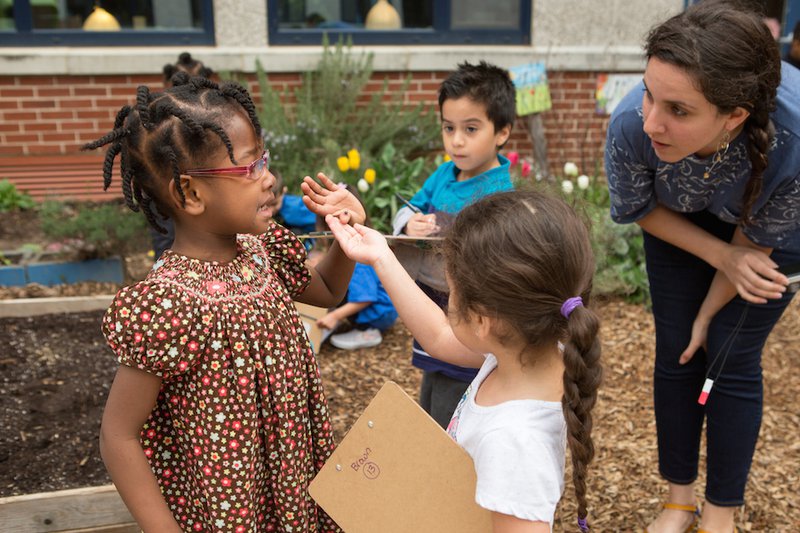Takeaways from New America and CEELO Blog Series on Early Learning and ESSA
Posts focused on how states could incorporate early learning into their ESSA plans
Blog Post

Courtesy of Allison Shelley/The Verbatim Agency for American Education: Images of Teachers and Students in Action
Sept. 5, 2017
September 18, 2017 is the final deadline for states to submit Every Student Succeeds Act plans for federal Department of Education review. Over the past four months, New America and CEELO have published a series of blogs on a wide range of topics by authors with diverse perspectives on early learning and education issues. Posts focused on how states could incorporate early learning into their ESSA plans and offered examples from state plans submitted in April. Below are some highlights and key takeaways, along with a discussion of what’s next.
Children’s transitions from pre-K to kindergarten are mentioned throughout ESSA. In her post, Michelle Horowitz of CEELO, explained research indicates continuity between pre-K and K combined with family involvement is critical to effective transitions throughout a child’s education. She offered New Jersey’s plan as an example of a state addressing transitions, highlighting the idea of creating “transition teams” including various groups of stakeholders to create plans based on local needs.
Another important topic, elevating the importance of teacher-child interactions, was addressed by Bonnie O’Keefe of Bellwether Education Partners, who suggested ESSA provides an opportunity for states to consider data on teacher-child interactions. Washington, DC and Louisiana provided examples, as both intend to use the Classroom Observation Scoring System to measure and improve these interactions.
In a post about ESSA provisions to support educators, Winona Hao of NASBE noted that early childhood educators are explicitly included in the definition of professional development under Title II for the first time in the federal education law. She discussed plans from four states that appear to be taking advantage of this new opportunity. Michigan’s ESSA plan calls for greater pay equity for birth-to-five educators and encourages districts to combine state and federal resources to address pay parity issues; Oregon plans to invest in induction and mentoring programs for preK-12 teachers; and Louisiana has proposed a range of programs focused on professional development and preparation of teachers.
And, in discussing how to make ESSA work in early childhood classrooms for dual language learners, Alexandra Figueras-Daniel of the National Institute for Early Education Research noted Nevada’s plan to provide extra funds for pre-K and full-day kindergarten to schools with high populations of DLLs. She also encouraged states to use this opportunity under Title IV, Part A, to provide a “well-rounded education” for young students, noting that early elementary grades tend to focus on literacy skills such as letter and word identification, while dual language learners — as well as all young children — would benefit from increased attention to building comprehension, vocabulary, and background knowledge.
Experts also discussed using ESSA to build a birth-through-third grade continuum, to include early learning in school improvement strategies and support family engagement. ESSA offers numerous opportunities for states to increase high-quality early learning opportunities, B-3rd grade. But it is up to states and localities to include early learning in their visions for education and to be willing to make meaningful investments.
Of the 17 plans submitted so far, seven states included early learning in an intentional way. Delaware made increasing access to high quality preschool and collaboration among public schools and community-based providers a key theme, and early learning is one of their five core priorities. Other states mentioned early learning in various places, but not in a comprehensive way, connecting it to other state priorities. Here are a few worth noting:
Embedding early education in accountability systems and school improvement plans ~ Colorado, New Mexico and Illinois, for example, plan to charge workgroups to identify school quality, school climate, and other indicators that could ensure that districts pay attention to the early years, P-3rd grade. Illinois is using CCSSO/CEELO’s Toolkit: Birth to Grade 3 Indicator Framework: Opportunities to Integrate Early Childhood in ESSA to explore K-2 indicators. (See the forthcoming blog on the toolkit)
Supporting early education educators ~ Arizona is using the National Association of Elementary School Principal’s Leading PreK Learning Communities to develop a leadership track for principals, and Michigan is encouraging districts to use Title IIa subgrants to collaborate with early learning programs and offer joint professional development.
In late October, CEELO will release an analysis of the first round of ESSA state plans to shine a spotlight on the early learning strategies and opportunities that will facilitate implementation at the local level of effective strategies to stop achievement gaps before they start showing up on standardized assessments at third grade.
The 34 remaining states will submit their plans this month for review by the Department of Education and then it will come time for implementation — where the rubber meets the road — and for districts to begin work on their own plans. Lots of work remains to implement ESSA, along with many opportunities to more intentionally focus on children’s early years, birth-through-third grade, in local plans.
In the coming weeks we’ll look at implementation and district plans. Let us know if you’re interested in joining the conversation and writing a blog on your state or district’s best practices to make early education a priority and reality for all children!